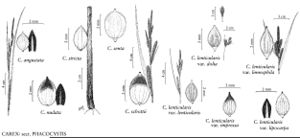Difference between revisions of "Carex lenticularis var. impressa"
Syst. Bot. Monogr. 7: 65. 1985.
IllustratedEndemic
Basionym: Carex interrupta var. impressa L. H. Bailey Mem. Torrey Bot. Club 1: 18. 1889
Synonyms: Carex limnaea T. Holm Carex paucicostata Mackenzie
FNA>Volume Importer |
imported>Volume Importer |
||
| (2 intermediate revisions by 2 users not shown) | |||
| Line 6: | Line 6: | ||
|place=7: 65. 1985 | |place=7: 65. 1985 | ||
|year=1985 | |year=1985 | ||
| + | }} | ||
| + | |special_status={{Treatment/ID/Special_status | ||
| + | |code=F | ||
| + | |label=Illustrated | ||
| + | }}{{Treatment/ID/Special_status | ||
| + | |code=E | ||
| + | |label=Endemic | ||
}} | }} | ||
|basionyms={{Treatment/ID/Basionym | |basionyms={{Treatment/ID/Basionym | ||
| Line 59: | Line 66: | ||
|publication title=Syst. Bot. Monogr. | |publication title=Syst. Bot. Monogr. | ||
|publication year=1985 | |publication year=1985 | ||
| − | |special status= | + | |special status=Illustrated;Endemic |
| − | |source xml=https:// | + | |source xml=https://bitbucket.org/aafc-mbb/fna-data-curation/src/2e0870ddd59836b60bcf96646a41e87ea5a5943a/coarse_grained_fna_xml/V23/V23_697.xml |
|genus=Carex | |genus=Carex | ||
|section=Carex sect. Phacocystis | |section=Carex sect. Phacocystis | ||
Latest revision as of 20:42, 5 November 2020
Culms 15–60 cm. Leaf blades 2–3.5 mm wide. Inflorescences: peduncle of proximal spike 1 cm; proximal bract red-brown at base, 1–3 mm wide. Spikes: proximal 3–5 spikes pistillate, 1.5–3.6 cm × 3–4 mm; terminal spike staminate. Pistillate scales red-brown or black. Perigynia with purple-brown spots on apical 1/2, 1–3 veins abaxially, ellipsoid or ovoid, 1.8–2.5 × 1.1–1.5 mm; stipe 0.2 mm; beak red-brown, 0.2–0.5 mm. 2n = 92.
Phenology: Fruiting Aug.
Habitat: Seasonally flooded river and lakeshores
Elevation: 1200–3000 m
Distribution

Calif., Idaho, Oreg., Wash.
Discussion
Primarily a taxon of the Sierra Nevada and southern Cascade Mountains, Carex lenticularis var. impressa tends to have smaller perigynia with fewer veins and more red-brown pigmentation than does the more widespread var. lipocarpa.
Selected References
None.
Lower Taxa
None.
